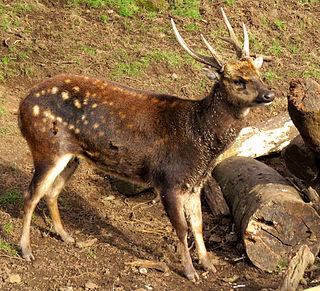
The Javan rusa or Sunda sambar is a deer native to Indonesia and East Timor. Introduced populations exist in a wide variety of locations in the Southern Hemisphere.

The Visayan spotted deer, also known as the Visayan deer, the Philippine spotted deer or Prince Alfred's deer, is a nocturnal and endangered species of deer located primarily in the rainforests of the Visayan islands of Panay and Negros though it once roamed other islands such as Cebu, Guimaras, Leyte, Masbate, and Samar. It is one of three endemic deer species in the Philippines, although it was not recognized as a separate species until 1983. An estimated 2,500 mature individuals survived worldwide as of 1996, according to the IUCN, although it is uncertain of how many of them still survive in the wild. The diet of the deer, which consists of a variety of different types of grasses, leaves, and buds within the forest, is the primary indicator of its habitat. Since 1991 the range of the species has severely decreased and is now almost co-extensive with that of the Visayan warty pig.

Macrovipera lebetinus schweizeri is a subspecies of venomous snake in the family Viperidae. The subspecies is endemic to the Cyclades Archipelago in the Aegean sea.
Lemurophoenix halleuxii is a species of palm tree, the only species in the genus Lemurophoenix. It is found only in Madagascar. It is threatened by habitat loss and overcollection. There are perhaps 300 mature individuals remaining in the wild.
The Ancash water frog is a species of frog in the family Telmatobiidae. It is endemic to Peru. Its natural habitats are subtropical or tropical high-altitude grassland and rivers with stony bottoms and weak currents. This species has been assessed as Vulnerable by the IUCN under criteria B1ab(iii,v), and has an extent of occurrence of 16,946 km2 across the Central Peruvian Andes at altitudes of 3,680–4,818 m asl. All populations occur in different hydrographic systems, and could qualify as being quite fragmented in its distribution, and though not specifically recorded, anthropogenic pressures such as pollution from mining concessions, collection for food and possible chytrid infection.

Crotalus pusillus is a venomous pit viper species found in west-central Mexico. No subspecies are currently recognized.
Polyscias pulgarensis, synonym Arthrophyllum pulgarense, is a species of plant in the family Araliaceae. It is endemic to the Philippines.
Polyscias crassa is a species of plant in the family Araliaceae. It is endemic to Seychelles. It is threatened by habitat loss.
Polyscias kikuyuensis, also called the parasol tree and mutati, is a species of plant in the family Araliaceae. It is endemic to Kenya, where its wood is used to make boxes and similar items. The species is confined to wet upland forest, and is threatened by habitat loss. Including the forests of Cherangani hills, Kenya.
Polyscias neraudiana is a species of plant in the family Araliaceae. It is endemic to Mauritius. It is threatened by habitat loss.

Polyscias paniculata is a species of flowering plant in the family Araliaceae. It is endemic to Mauritius. It is threatened by habitat loss.

Polyscias sandwicensis, known as the 'ohe makai or ʻOhe kukuluāeʻo in Hawaiian, is a species of flowering plant in the family Araliaceae, that is endemic to Hawaii. It is a tree, reaching a height of 4.6–15 m (15–49 ft) high with a trunk diameter of 0.5–0.6 m (1.6–2.0 ft). It can be found at elevations of 30–800 m (98–2,625 ft) on most main islands. Polyscias sandwicensis generally inhabits lowland dry forests, but is occasionally seen in coastal mesic and mixed mesic forests. It is threatened by habitat loss.
Polyscias gymnocarpa, commonly known as the Koolau Range 'ohe or Koʻolau tetraplasandra, is a species of flowering plant in the family Araliaceae, that is endemic to the Hawaiian island of Oʻahu. It is threatened by habitat loss.
Mixcoatlus barbouri is a venomous pit viper species endemic to Mexico. No subspecies are currently recognized.

Mixcoatlus melanurus is a venomous pitviper species endemic to the mountains of southern Mexico. No subspecies are currently recognized.

Endangered species as classified by the International Union for Conservation of Nature (IUCN), are species which have been categorized as very likely to become extinct in their known native ranges in the near future. On the IUCN Red List, endangered is the second most severe conservation status for wild populations in the IUCN's schema after critically endangered. In 2012, the IUCN Red List featured 3,079 animal and 2,655 plant species as endangered worldwide. The figures for 1998 were 1,102 and 1,197 respectively.
Photuris bethaniensis is a species of firefly in the genus Photuris.

Polyscias fulva is a species of flowering plant. It is an evergreen or deciduous tree, native to the mountains of tropical Africa and the southwestern Arabian Peninsula.









